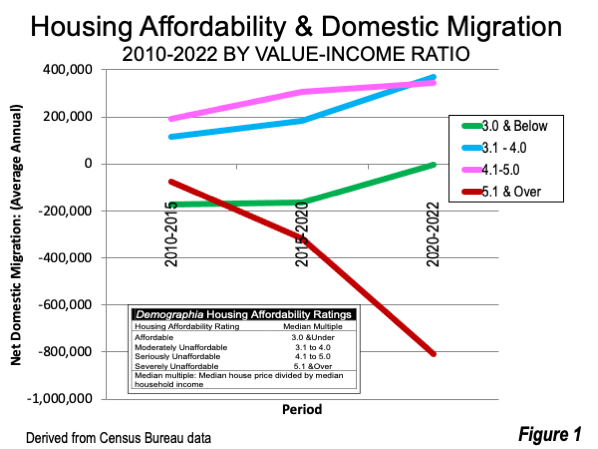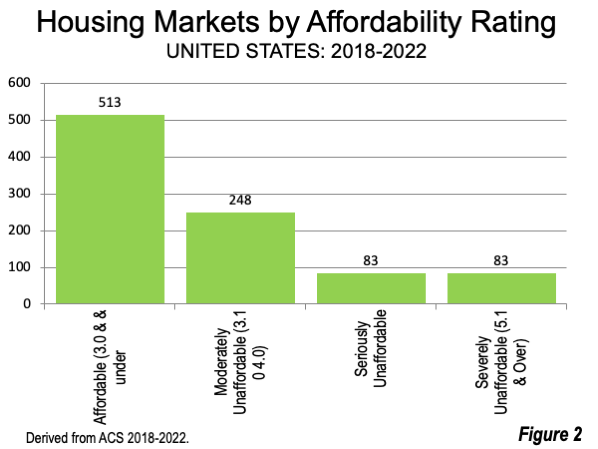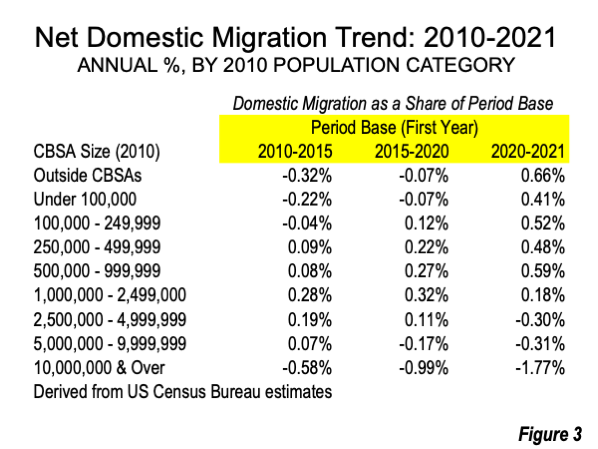
In recent years, driven by the rising cost of living and the remote work revolution, Americans have been moving to more affordable housing markets. This is evident in an analysis of American Community Survey data gathered over five years (2018 to 2022).
Housing Affordability and Net Domestic Migration: The Nexus
This article looks at average annual net domestic migration for 927 metropolitan and micropolitan areas in the national housing market. The median house values were divided by the median households incomes, yielding a value to income ratio. This uses the Demographia housing affordability ratings that consider 3.0 or below as affordable, 3.1 to 4.0 as moderately unaffordable, 4.1 to 5.0 is seriously unaffordable and 5.1 or higher as severely unaffordable.
Figure 1 shows that since 2010 housing affordability net domestic migration (moving between locations in the 50 states and the District of Columbia) has been strongly moving from the least affordable markets to the more affordable markets.
Among the more unaffordable markets, net outward migration from the severely unaffordable markets increased from a net loss of 76,000 for 2010 to 2015 to a net loss of 810,000 in 2021 and 2022. These costly markets lost a population equal to that of the city of San Francisco. Most of these losses occurred in the largest markets, New York, Los Angeles and Chicago.
Among the seriously unaffordable markets, net migration domestic had an annual gain of 190,000 in 2010 to 2015 and rose to 345,000 in 2021 - 2022.
Among the moderately unaffordable markets, net domestic migration has risen from a gain of 116,000 in 2010 average to 369,000 for 2020 to 2022. Among the affordable markets there was a net loss of 171,000 on average between 2010 and 2015, which dropped to a net loss of only 4,000 in 2021 to 2022.
These trends are illustrated in Figure 1 (above)
More Than 500 Affordable Markets
Out of the 927 markets, more than 1/2 are affordable (513). Another nearly 250 markets are moderately unaffordable, while 83 are seriously unaffordable and the same number is severely unaffordable (Figure 2). The severely unaffordable markets are generally more strongly regulated, and often have urban containment regulation, which creates upward spikes in land at values at surrounding urban growth boundaries and greenbelts. These increases are telescoped throughout the area confined by the urban growth boundaries or greenbelt.
At the same time we have previously reported on the fact that net domestic migration is moving strongly away from larger markets (Figure 3). The strongest net in-migration has been in the smallest population category, markets with populations below 100,000. This is an entirely new demographic pattern, as opposed to most growth being in the larger metropolitan areas.
The Most Affordable Markets
An attachment to this article provides housing affordability ratings for all 927 markets. (View/download the list of 927 U.S. Housing Markets) Overall, six markets are tied for the most affordable in the nation, at a value to income ratio of 1.6. These markets are Borger, Texas; Centralia, Illinois; Gallup, New Mexico; Raymondville, Texas; and Vernon, Texas. Another five markets have value to income ratios of 1.7, including Bradford, Pennsylvania; Decatur, Illinois; Pampa, Texas; Parsons, Kansas and Pearsal, Texas. In these areas, housing is far less costly than the more expensive markets, such as San Jose, Los Angeles and Honolulu, where prices are more than 10 times incomes.
Some of these communities are close enough to larger metropolitan areas for people to work from home a day or two a week. In our increasingly dispersed economy, the lower cost of living typical of smaller communities and their lifestyles, which tends to be slower and more family oriented, has become more attractive in recent years.
Wendell Cox is principal of Demographia, an international public policy firm located in the St. Louis metropolitan area. He is a founding senior fellow at the Urban Reform Institute, Houston, a Senior Fellow with the Frontier Centre for Public Policy in Winnipeg and a member of the Advisory Board of the Center for Demographics and Policy at Chapman University in Orange, California. He has served as a visiting professor at the Conservatoire National des Arts et Metiers in Paris. His principal interests are economics, poverty alleviation, demographics, urban policy and transport. He is co-author of the annual Demographia International Housing Affordability Survey and author of Demographia World Urban Areas.
Mayor Tom Bradley appointed him to three terms on the Los Angeles County Transportation Commission (1977-1985) and Speaker of the House Newt Gingrich appointed him to the Amtrak Reform Council, to complete the unexpired term of New Jersey Governor Christine Todd Whitman (1999-2002). He is author of War on the Dream: How Anti-Sprawl Policy Threatens the Quality of Life and Toward More Prosperous Cities: A Framing Essay on Urban Areas, Transport, Planning and the Dimensions of Sustainability.
Photograph: Bradford, PA, Old City Hall via Wikimedia in Public Domain.















